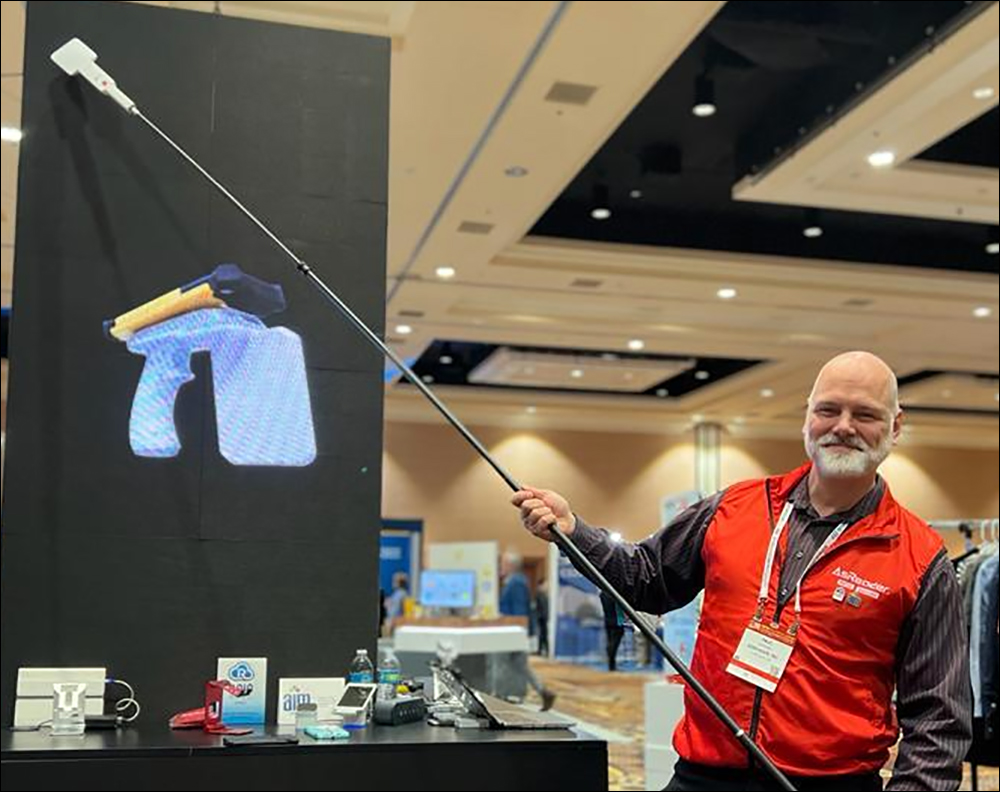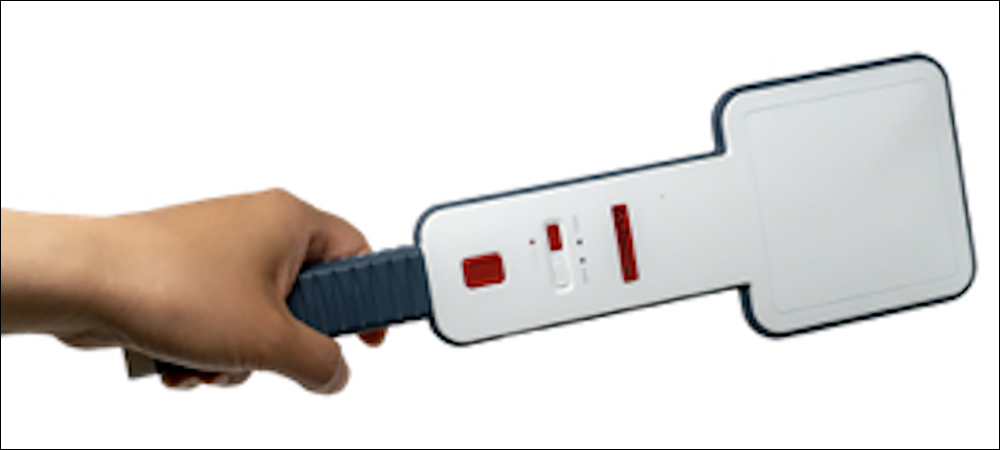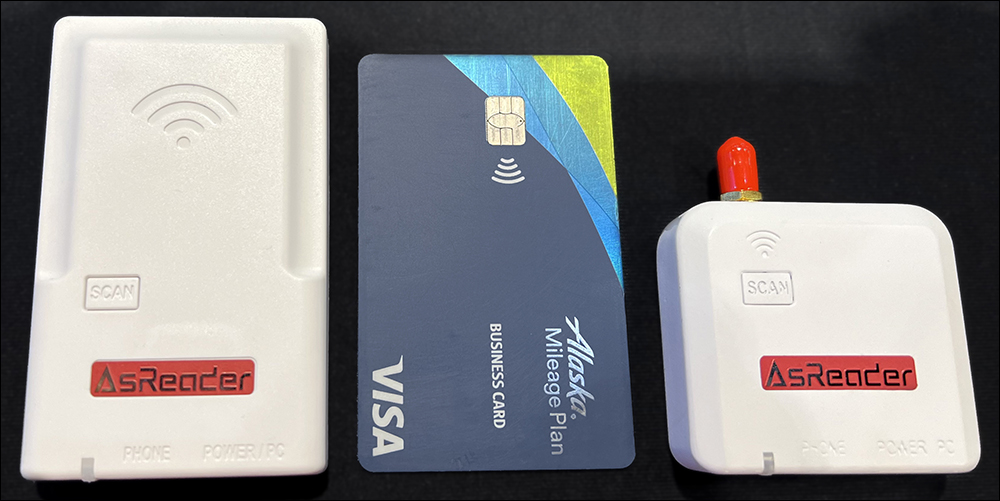AsReader will demonstrate its technology at RFID Journal LIVE! 2023 in booth 517. The event will feature end-user companies discussing RFID’s use in various industries, as well as exhibitors offering tagging solutions for multiple applications.
AsReader has released several new products intended to deliver radio frequency identification (RFID) reading capability to challenging locations. The company’s Paddle-Type RFID reader (ASR-P252B) enables users to interrogate tags on high shelves or under loaded pallets, where tag reads can be most difficult. In addition, the company has released two pocket-sized readers that can be deployed on desktops on mounted on walls for mobile or temporary RFID read applications. AsReader says it is releasing the new products as part of its mission to bring RFID technology to a wider set of environments where traditional RFID readers may not be able to capture tag reads.
The Paddle-Type reader has been used in Japan and is now being released in the United States, followed by its commercial release in Europe in June, according to Paul Whitney, AsReader’s chief operating officer. The company will demonstrate its products at RFID Journal LIVE! 2023, being held in Orlando, Fla., on May 9–11. The reader is designed for use in the retail and medical industries, as well as in warehouses or yards in which goods may be stacked or otherwise difficult to reach, whether they are on pallets or shelves, or in the backs of trucks.

The Paddle-Type RFID reader extends a user’s reach.
The device consists of a reader module and an antenna array, encompassing the size of an elongated ping-pong paddle, and includes a built-in 2D/1D barcode scanner. It is designed to connect to a pole or extending arm, and it comes with two receptables: one a quarter-inch-diameter connection on the bottom, the other in the center of the reader. Thus, users can apply the extender pole of their choice, reaching 20 to 30 feet, then transmit read or scan data to a separate iOS- or Android-based device via a Bluetooth connection. It can also be hardwired with a USB connection.
The device provides a maximum read range of about 6 meters (19.7 feet), approximately half the read distance of AsReader’s ASR-L251G Gun-Type device. That shorter range is part of the design, Whitney reports, with a smaller, circular antenna, as opposed to the Gun-Type’s linear design. He likens the antennas in the two products to a light bulb versus a spotlight, adding, “You’re shooting [RF energy] in front and back and sideways, instead of all in front.”
Broomsticks and Lift Trucks to Extend Reach

Paul Whitney
With its new product, AsReader expects companies will be able to read tags in places that are usually out of reach. This includes those packed tightly together on a loaded pallet, at the bottom or inside of a stack, or too high to reach when someone is standing on the floor. When it comes to loaded pallets, AsReader says customers are using the Paddle-Type device to slide under the pallet stack in the space dedicated to forklift tines, in order to read tags from underneath.
Whitney says the Paddle-Type reader is designed to help users that have a lot of metal material on pallets, obstructing RF transmissions. Another use case that the product is designed to target involves reading metal objects stacked on the backs of trucks. Such an application can include steel pipes used in construction, which are often stacked 30 feet high inside the back or trailer of a vehicle.
For many businesses introducing RFID into their logistics or operations, tags may not be readable on a truck even if they are applied to pipes and can be read on the ground. That’s important, Whitney notes, because companies use the technology to identify goods as orders leave a site or arrive with a specific number of products expected. There may be ten pipes on a vehicle, for example, but an employee with a reader might capture only seven tag reads. Companies do not want workers to climb up to read those tags, he says, out of concern for efficiency and safety.
Reading Out of Reach Tags in Japan
As RFID has proliferated, some companies are leveraging their own ingenuity to accomplish tag reads in hard-to-reach places. Whitney has seen operators duct-tape a reader to a long broomstick or a window-washing pole, for instance, or to some other extender that can lengthen an employee’s reach. In other cases, workers have been raised up on forklifts with a handheld reader to capture tags. The Paddle-Type reader is intended to put an end to such unsafe practices.

The ASR-P252B reader
With the short read range, AsReader explains, workers can capture more targeted reads at a distance, as opposed to capturing other items from the high vantage point. The company has found that users are choosing to turn the power down, Whitney says, “So you’re not reading from 20 feet—you’re just reading a few feet or one foot, until the reader is almost touching the tag.” This, he explains, provides assurance that a pipe an employee is looking at from a distance is the one whose tag is being read. With the Bluetooth functionality, workers typically use both hands—one to handle the extended reader, the other to view the resulting data regarding tag reads on their phone or table.
Companies deploying the readers in Japan have typically had workers reach the paddles under pallets or extend them toward a warehouse ceiling, where pallets may be stacked five or six levels up. In addition, some retailers are using the device as part of the process of “fluffing” merchandise on hangers (ensuring garments hang evenly and are visible to customers) and reaching inside deep, metal cabinets. The paddles, simply inserted between items, help to perform fluffing of the fabric as they capture tag reads. With two extension-pole receptacles on each reader—one at the base of the handle, another in the middle of the device—users can accomplish a 90-degree angle to turn the paddle, such as between or under pallets stacked high and out of reach of workers.
Credit-Card-Sized Desktop Readers
AsReader has released two versions of another device, the Desktop-Type readers, that are little bigger than a credit card. The P35 is self-contained, the company indicates, with a reader and antenna built into a small device that can be placed on a counter or desktop and be plugged into a PC, laptop or Android-based device for power and connectivity. It also works with iOS devices with a power adapter. Use cases include reading tags at temporary sites, such as at a conference or event at which RFID badges need to be read as attendees enter a venue.

The company’s Desktop-Type readers are about the size of a credit card.
The device comes with a manual button to trigger the read, enabling users to configure the reader to only interrogate a tag when the button is pushed. The P37 is smaller but does not include an antenna, so it comes with an external antenna port, and users would need to connect an antenna of their choice to the reader. The device could be used at a cabinet to read items such as jewelry on a tray placed on the reader antenna, or it could be installed on a showroom floor.
In Japan, AsReader indicates, many companies are already using the pocket-sized readers. With a high-power antenna, Whitney says, some are using the P37 to capture tag reads at a relatively long distance, for mobile deployments that can interrogate tags entering and exiting a space in the same way a fixed reader typically does. Both readers are now also available in the United States.
Key Takeaways:
- AsReader’s Paddle-Type reader and antenna captures tag reads on high shelves, at the tops of trucks and under pallets.
- The company has also released two new desktop readers sized similarly to a credit card, designed to read tags in mobile or temporary locations.

